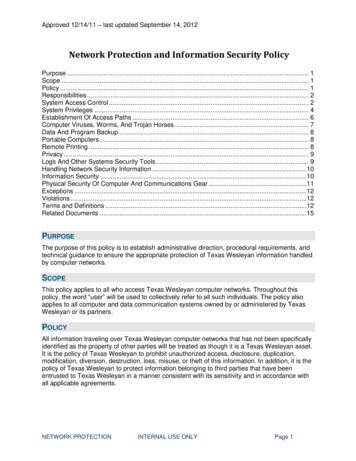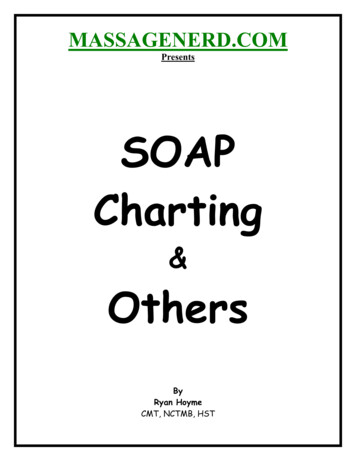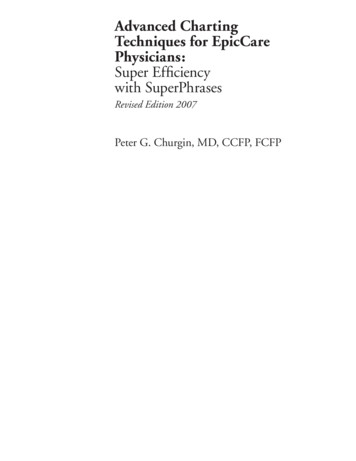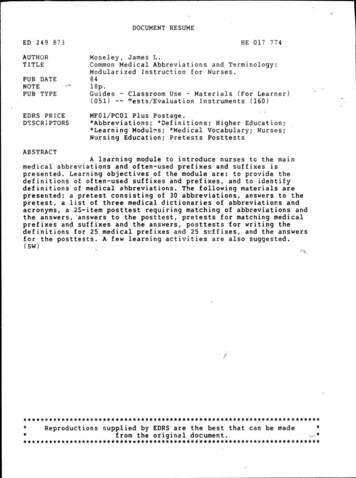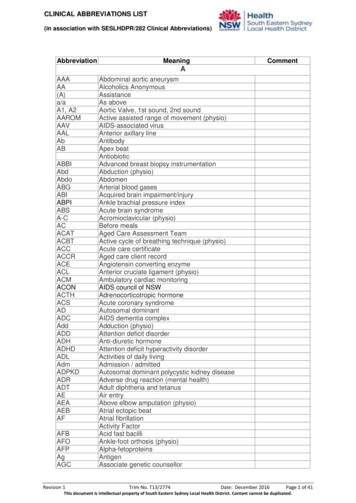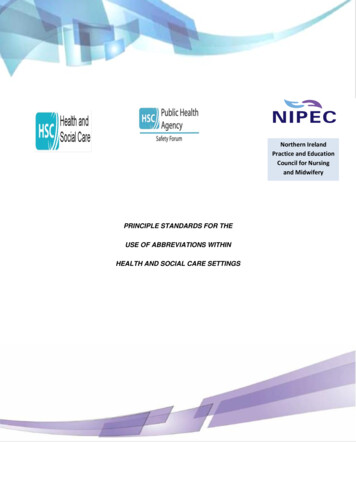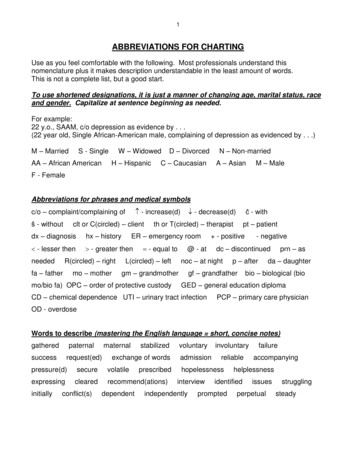
Transcription
1ABBREVIATIONS FOR CHARTINGUse as you feel comfortable with the following. Most professionals understand thisnomenclature plus it makes description understandable in the least amount of words.This is not a complete list, but a good start.To use shortened designations, it is just a manner of changing age, marital status, raceand gender. Capitalize at sentence beginning as needed.For example:22 y.o., SAAM, c/o depression as evidence by . . .(22 year old, Single African-American male, complaining of depression as evidenced by . . .)M – MarriedW – WidowedS - SingleAA – African AmericanH – HispanicD – DivorcedN – Non-marriedC – CaucasianA – AsianM – MaleF - FemaleAbbreviations for phrases and medical symbols - increase(d)c/o – complaint/complaining ofŝ - withoutclt or C(circled) – clientdx – diagnosishx – history - lesser then - greater thenR(circled) – rightneededfa – fathermo – mother - decrease(d)ĉ - withth or T(circled) – therapistER – emergency room - equal toL(circled) – leftmo/bio fa) OPC – order of protective custody - positive@ - at- negativedc – discontinuednoc – at nightgm – grandmotherpt – patientp – aftergf – grandfatherprn – asda – daughterbio – biological (bioGED – general education diplomaCD – chemical dependence UTI – urinary tract infectionPCP – primary care physicianOD - overdoseWords to describe (mastering the English language short, concise abilizedexchange of eady
2relationshipfacilityrole modelfather/mother figureprocessfurther explorationsporadicpsychopathologyhigh gradeoscillatingoverlappingside dgmentinsightchroniclimitedsupport systemself-destructivecriteriaadamantlyvoices . . .supportivealertorientedgoal llow gradeWith regards to . . sdeniesas safety *********Writing SOAP Notes(taken (with additions) from Learning to Write Case Notes Using the SOAP Format –Susan Cameron and Imani turtle-song)SOAP notes were developed in 1964 by L.L.Weed to enhance continuity of client care andassist in better recall/communication of details between and for the healthcare professional.Other case notes that are variations of the SOAP note model include:DAP – Data, Assessment, PlanFOR – Functional Outcomes ReportingUsing the SOAP FormatThe four components of SOAP notes are:(S) subjective(O) objective(A) assessment(P) planS – Subjective information about the presenting problem from the client’s perspective.O – Objective information observed by the counselor.
3A – Assessment that demonstrates how the S and O data is formulated/interpreted/reflectedupon.P – plan summarizing of the direction of treatment.SubjectiveThis section can be the most troublesome. Here the client’s feelings, goals and thoughts aswell as the intensity of the problem and how it may affect significant other(s) are recorded. Theentry should be as brief and concise as possible without the overuse of quotations since atthe end of a session, research shows that it is unlikely to accuratelyremember verbatim information. If, however quotations are used, only key words or phrasesshould be recorded. For example, this might include a suicidal or homicidalideation, unwillingness to provide necessary information, inappropriately aggressive or abusivelanguage that the counselor may deem threatening.For instance, a father accused of shaking his 6-month-old daughterwhen she would not stop crying says, “I only scared her when Ishook her, I didn’t hurt her.”The counselor might write: “Minimizes the effects of shaking infantdaughter. States, “I only scared her.” Use only a minimum of quotesWays to write briefly, yet concisely:The client may say, “Therapy is really helping me put my life intoperspective,” (10 words), could be written “Reports therapy is really helping.”(Five words)Rather than using names of specific people’s names, use general terms as “fellow employee”or “mental health worker”, and briefly report the themes of the client’s complaint.The content of the S section belong to the client. For brevity’s sakes, the counselorshould write, “reports, states, says, describes, indicates, complains of.For example, instead of writing, “Today the client says, ‘I am experiencingmuch more marital trouble since the time before our last session’ (14 words),the counselor might write, “Client reports increased marital problem sincelast session.” (8 words).ObjectiveThis information should be factual and in quantifiable terms – that which can be seen,heard, smelled, counted or measured. Avoid words such as “appeared” or “seemed”without objective supporting evidence. Avoid labels, personal judgments, opinionatedstatements. Words that carry a negative connotation such as, “uncooperative”, “manipulative,”“abusive,” “obnoxious,” “spoiled,” “dysfunctional,” and “drunk.” Thesewords are open to personal interpretation. The most helpful phrase is, “as evidenced by.”
4For example, “Appeared depressed, as evidenced by significantlyless verbal exchange; intermittent difficulty tracking. Hair uncombed,clothes unkept. Denies feeling depressed.”Simply record what is seen, heard, or smelled.For example, “Client smelled of alcohol; speech slow and deliberatein nature; uncontrollable giggles even after stumbling against doorjam; unsteady gait.”AssessmentThis section summarizes the counselor’s clinical thinking. Clinical impressions may also beused to “rule out” or “rule in” a diagnosis. Clinical impressions also enable viewers to follow thecounselor’s reasoning and direction for treatment. When makinga diagnostic impression, ask the question, “Is there adequate/sufficient data here to support aclinical diagnosis?” If sufficient data has been collected, the S and O sections shouldreasonably support the diagnosis. If, however, there is ambivalence in makinga diagnosis this might suggest insufficient data has been collected or that a consultation with asenior colleague is in order.PlanThis section describes the parameters of the intervention. It consists generally of two parts, theaction plan and the prognosis. It may include a referral to an agency or some other form ofintervention. The prognosis is a forecast of the probable gains to be made by the plan.ScenarioCecil is a 34-year-old man who was mandated by the courts to obtain counseling to resolve hisproblems with domestic violence. He comes into the office, slams the door, and announces ina loud and irritated voice, “This counseling stuff is crap! There’s noparking! My wife and kids are gone! And I gotta pay for something that don’t work!”Through most of the counseling session Cecil remains agitated. Speaking in an angry andaggressive voice, he tells you that his probation officer told him he was a good man and couldget his wife and kids back. He demands to know why you are not really helping him get backwhat is the most important to him. He insists that, “Mary just screws everything up?” He goeson to tell you of a violent argument he and Mary had last night regarding the privileges of theirdaughter Nicole, who just turned 16. You are aware that there is a restraining order againstCecil.During the session, you learn Cecil was raised in a physically and verbally abuse family untilhe was 11, at which time he was placed in protective custody by social services, where heremained until he was18. He goes on to tell you that he has been arrested numerous times for“brawling” and reports that sometimes the littlest things make him angry and he just explodes,hitting whatever is available – the walls, his wife, the kids, and three guys at work. Cecil also
5reports prior arrests for domestic violence. He admits that at various time, he has been bothphysical and emotionally abusive to Mary and the children but insists that it was needed to“straighten them out.” Just before leaving your office, Cecil rushes from his chair and standswithin a foot of you. Angrily, with his fist and jaw clenched, he says, “This is the same old B.S.You guys are just all talk.” He storms from the room.Sample SOAP note (using abbreviations and meanings not put in above notes)S: Reports cslng (counseling) not helpful in getting family back. Insists on violence to“straighten out” family. Reports hx (history) of DV(Domestic violence). States verbally fought ĉ(with) wife over oldest child’s privileges. Clt. or C (circled) reported personal physical andmental abuse as child resulting foster care placement, ages 8-11.O: Generally agitated in session as evidenced by clenched fist and jaw. Near end ofsession, clt or C(circled) stated counseling is “same old B.S!” Rushed out of office.A: Physical abuse as adult and child.P: Prognosis guarded due to (decreases or low) level of motivation to change. Will continuetherapy. Possible referral to Dr. for psych. (psychiatric)eval.(evaluation) and Men’s Alternative Violence Group. Next session, introduce use of “timeouts.”
Sample SOAP note (using abbreviations and meanings not put in above notes) S: Reports cslng (counseling) not helpful in getting family back. Insists on violence to “straighten out” family. Reports hx (history) of DV(Domestic violence). States verbally fought ĉ (with) wife over oldest child’s privileges. Clt. or C (circled) reported personal physical and mental abuse as child resulting .

